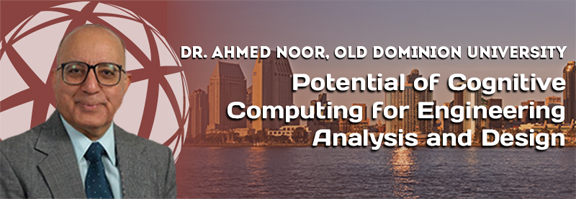
NAFEMS World Congress will be held in San Diego, California, covering a range of topics on the simulation discipline.
Latest News
June 9, 2015
 NAFEMS World Congress will be held in San Diego, California, covering a range of topics on simulation.
NAFEMS World Congress will be held in San Diego, California, covering a range of topics on simulation. Dr. Ahmed Noor’s keynote at NAFEMS World Congress
Dr. Ahmed Noor’s keynote at NAFEMS World CongressIn his keynote address at the upcoming NAFEMS World Congress (June 21-24, San Diego, California), Dr. Ahmed Noor, a researcher and scholar from the Old Dominion University, will be talking about “cogs,” among other things.
These cogs are not the wheels and gears that once drove the steam engine-era industrial activities; they’re at the heart of what could very well be the new IoT-era industrial revolution. They are, in Noor’s words, “Cognitive computing for engineering analysis and design.”
“We are witnessing a new revolution in computing and communication, brought about by the synergistic couplings of a number of technologies, including cognitive computing, internet of things (IoT), mobile and wearable devices, big data prescriptive analytics, among others,” he said. In his talk, he plans to “identify some of the characteristics of the coming intelligence / convergence / mass customization era, the future cognitive cyber-physical engineering systems (beyond today’s autonomous systems), and their implications on the product creation tools, facilities and environments.”
The human-machine interaction so far has been marred by anxiety and distrust—the fear that automation and AI threatens human supremacy. It’s a dystopian vision we have seen depicted in movies like The Terminator and The Matrix. Noor has heard some of his peers express similar concerns. “With all due respect, I don’t share their paranoia,” he said. He believes it’s possible to achieve “human-machine symbiosis,” where “humans are always in the loop and both work together so the overall system functions at its best.” He looks to wearable computing devices as a precursor to the symbiosis.
He envisions “cog-assisted product development technologies, where every phase is aided by cognitive computing and predictive analytics.” At the moment, however, he acknowledges such tools are almost nonexistent in in the commercial market; promising versions of it are difficult to find even among university research projects. “IBM is working very hard to develop this type of intelligence,” he pointed out. “Engineering and simulation software vendors should seize the moment and work to integrate this feature in their next-generation offerings.” (For more on this, read Noor’s article on cognitive computing as a Game Changer (in PDF), or visit IBM Research’s home page on cognitive computing.)
Considering the fast pace of change, Noor suggested we should learn to become much more nimble and agile. “Nobody should have a five-year plan that cannot easily be changed,” he cautioned. “We should revisit our plans and strategies once in a while, perhaps every two months, and revise them in response to the changes we see.”
Noor sees NAFEMS World Congress as an event that “brings together engineers, researchers, scientists, and software developers so they can work collaboratively and accomplish much more than they can individually in their own space.” His keynote is scheduled for the morning of Tuesday June 23.
To register to attend NAFEMS World Congress, go to http://nafems.org/congress.
Subscribe to our FREE magazine, FREE email newsletters or both!
Latest News
About the Author
Kenneth Wong is Digital Engineering’s resident blogger and senior editor. Email him at [email protected] or share your thoughts on this article at digitaleng.news/facebook.
Follow DERelated Topics






